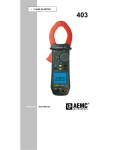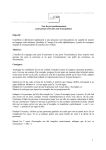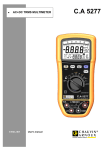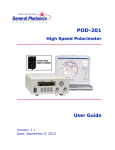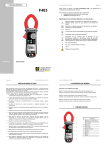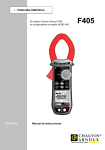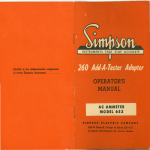Download AEMC-403-User Manual - Weschler Instruments
Transcript
CLAMP-ON METER Authorized Distributor: WESCHLER INSTRUMENTS phone: 800-903-9870 440-378-6580 fax: 800-903-9590 440-238-0660 www.weschler.com [email protected] EN G LI S H User Manual 403 2 CONTENTS RECEIVING YOUR SHIPMENT........................................................................... 7 ORDERING INFORMATION................................................................................ 7 1 PRESENTATION .......................................................................................... 8 1.1 THE ROTARY SWITCH................................................................................... 9 1.2 THE FUNCTION BUTTONS.......................................................................... 10 1.3 THE DISPLAY ................................................................................................ 11 1.3.1 Display Symbols ........................................................................... 11 1.3.2 Measurement Capacity Exceeded (OL) ........................................ 12 1.4 THE TERMINALS........................................................................................... 12 2 THE BUTTONS........................................................................................... 13 2.1 2.2 2.3 BUTTON ................................................................................................. 13 2.4 2.4.1 2.4.2 BUTTON.............................................................................................. 15 Normal Mode ................................................................................ 15 The MAX/MIN Mode + Activation of the HOLD Mode ................... 16 2.4.3 2.5 2.5.1 2.5.2 Access to the True Inrush™ Mode ( set to ) ............... 16 BUTTON................................................................................................ 17 Normal Mode ................................................................................ 17 The Hz Function + Activation of the HOLD Mode ......................... 17 2.6 3 (YELLOW) BUTTON (SECOND FUNCTION).............................................. 14 BUTTON................................................................................................ 14 BUTTON.............................................................................................. 18 USE............................................................................................................. 19 3.1 INSTALLING THE BATTERIES .................................................................... 19 3.2 TURNING THE CLAMP-ON METER ON...................................................... 19 3.3 TURNING THE CLAMP-ON METER OFF.................................................... 19 3.4 CONFIGURATION......................................................................................... 20 3.4.1 Configuring the Maximum Resistance for Continuity .................... 20 3.4.2 Auto Power OFF ........................................................................... 20 3.4.3 Configuring the Threshold for True InRush™ Measurement......... 20 3.4.4 Changing the Default Temperature Unit ....................................... 21 3.4.5 Configuring the Adapter Function Scale Factor ............................ 21 3.4.6 Default Configuration .................................................................... 22 3.5 VOLTAGE MEASUREMENT (V)................................................................... 22 3.6 CONTINUITY TEST ................................................................................. 23 3.6.1 Lead Resistance Compensation ................................................... 23 3.7 RESISTANCE MEASUREMENT .............................................................. 24 3.8 DIODE TEST ............................................................................................ 24 3.9 CURRENT MEASUREMENT (A).................................................................. 25 3.9.1 AC Measurement .......................................................................... 25 3 3.9.2 DC Measurement.......................................................................... 26 3.10 STARTING CURRENT OR OVERCURRENT (True InRush™) MEASUREMENT ........................................................................................... 27 3.11 FREQUENCY MEASUREMENT (HZ)........................................................... 27 3.11.1 Frequency Measurement (V) ........................................................ 27 3.11.2 Frequency Measurement (A) ........................................................ 28 3.12 TEMPERATURE MEASUREMENT.............................................................. 29 3.12.1 Measurement without External Sensor ......................................... 29 3.12.2 Measurement with External Sensor .............................................. 29 3.13 ADAPTER FUNCTION MEASUREMENT.................................................... 30 4 SPECIFICATIONS ...................................................................................... 31 4.1 REFERENCE CONDITIONS......................................................................... 31 4.2 SPECIFICATIONS UNDER THE REFERENCE CONDITIONS.................. 31 4.2.1 DC Voltage Measurement............................................................. 31 4.2.2 AC Voltage Measurement............................................................. 32 4.2.3 DC Current Measurement............................................................. 32 4.2.4 AC Current Measurement ............................................................. 33 4.2.5 True Inrush™ Measurement ......................................................... 33 4.2.6 Continuity Measurement ............................................................... 33 4.2.7 Resistance Measurement ............................................................. 34 4.2.8 Diode test...................................................................................... 34 4.2.9 Frequency Measurements ............................................................ 34 4.2.10 Temperature Measurement........................................................... 35 4.2.11 Adapter Function Measurement.................................................... 36 4.3 ENVIRONMENTAL CONDITIONS ............................................................... 36 4.4 MECHANICAL SPECIFICATIONS ............................................................... 37 4.5 POWER SUPPLY........................................................................................... 37 4.6 COMPLIANCE WITH INTERNATIONAL STANDARDS.............................. 37 4.7 ENVIRONMENTAL VARIATIONS ................................................................ 38 5 MAINTENANCE.......................................................................................... 39 5.1 5.2 5.3 WARNING ...................................................................................................... 39 CLEANING ..................................................................................................... 39 REPLACEMENT OF THE BATTERIES........................................................ 39 6 REPAIR AND CALIBRATION .................................................................... 40 7 TECHNICAL AND SALES ASSISTANCE.................................................. 40 8 LIMITED WARRANTY ................................................................................ 41 9 WARRANTY REPAIRS .............................................................................. 41 4 Thank you for purchasing a Model 403 Clamp-on Meter. For best results from your instrument and for your safety, read the enclosed operating instructions carefully and comply with the precautions for use. These products must be only used by qualified and trained users. Meanings of the symbols used on the device CAUTION - Risk of Danger! Indicates a WARNING and that the operator must refer to the user manual for instructions before operating the instrument in all cases where this symbol is marked. Risk of electric shock. The voltage at the parts marked with this symbol may be dangerous. Refers to a type A current sensor. This symbol signifies that application around and removal from HAZARDOUS LIVE conductors is permitted. 1.5 V battery The CE marking indicates compliance with European directives Double insulation or reinforced insulation In the European Union, this product is subject to a separate collection system for recycling electrical and electronic components In accordance with directive WEEE 2002/96/EC AC – Alternating current AC and DC – Alternating and direct current Ground/Earth 5 PRECAUTIONS FOR USE This device complies with safety standards IEC-61010-1 and 61010-2-032 for voltages of 1000V in category IV at an altitude of less than 2000m, indoors, with a degree of pollution not exceeding 2. These safety instructions are intended to ensure the safety of persons and proper operation of the device. The operator and/or the responsible authority must carefully read and clearly understand the various precautions to be taken in use. If this instrument is used other than as specified, the protection it provides may be compromised, thereby endangering you. Do not use the instrument in an explosive atmosphere or in the presence of flammable gases or fumes. Do not use the instrument on networks of which the voltage or category exceeds those mentioned. Do not exceed the rated maximum voltages and currents between terminals or with respect to earth. Do not use the instrument if it appears to be damaged, incomplete, or not properly closed. Before each use, check the condition of the insulation on the leads, housing, and accessories. Any element of which the insulation is deteriorated (even partially) must be set aside for repair or scrapped. Use leads and accessories rated for voltages and categories at least equal to those of the instrument. If not, an accessory of a lower category lowers the category of the combined Clamp + accessory to that of the accessory. Observe the environmental conditions of use. Replace the batteries as soon as the symbol appears on the display of the unit. Disconnect all leads before opening the battery compartment cover. Use personal protective equipment when conditions require. As a safety measure, and to avoid repeated overloads on the inputs of the device, configuration operations should only be performed when the device is disconnected from all dangerous voltages. Do not modify the instrument and only use factory replacement parts. Repairs and adjustments must be done by approved qualified personnel. Keep your hands away from the unused terminals of the instrument. When handling the test probes, alligator clips, and clamp ammeters, keep your fingers behind the physical guard. 6 MEASUREMENT CATEGORIES Definitions of the measurement categories : CAT II: Circuits directly connected to the low-voltage installation. Example: power supply to household electrical appliances and portable tools. CAT III: Power supply circuits in the installation of the building. Example: distribution panel, circuit-breakers, fixed industrial machines or devices. CAT IV: Circuits supplying the low-voltage installation of the building. Example: power lines, meters, and protection devices. RECEIVING YOUR SHIPMENT Upon receiving your shipment, make sure that the contents are consistent with the packing list. Notify your distributor of any missing items. If the equipment appears to be damaged, file a claim immediately with the carrier and notify your distributor at once, giving a detailed description of any damage. Save the damaged packing container to substantiate your claim. ORDERING INFORMATION Clamp-on Meter Model 403 .......................................................... Cat. #2139.21 Includes set of 2 color-coded silicone insulated test leads, test probes and alligator clips, K-thermocouple with 4mm integrated adapter, soft carrying case, 4x1.5V AA batteries and user manual. Replacement Parts: K-thermocouple with 4mm Integrated Adapter................................................Cat. #2139.71 Soft Carrying Case .........................................................................................Cat. #2139.72 Set of 2 Color-coded Silicone Test Leads, Test Probes & Alligator Clips ........ Cat. #2152.05 7 1 PRESENTATION The Clamp-on Meter Model 403 is a professional electrical measuring instrument that combines the following functions: Current measurement Measurement of InRush current / overcurrent (True InRush™) Voltage measurement Frequency measurement Continuity test with buzzer Resistance measurement Diode test Temperature measurement Adapter function (for use with external transducers/measurement devices) 1 Item See § 1 Jaws with centering marks 3.5 to (see connection principles) 3.12 2 Physical Guard 3 Rotary Function Switch 4 Function Buttons 5 Backlit Display 1.3 6 Input Terminals 1.4 7 Trigger 2 7 Designation 1.1 3 4 5 6 Figure 1: Clamp-on Meter Model 403 8 2 - 1.1 THE ROTARY SWITCH The rotary switch has six positions. To access the , , , , , functions, set the switch to the desired function. The functions are described in the table below. 6 5 4 3 2 1 Figure 2: The Function Rotary Switch Item Function See § 1 OFF mode – Turns the clamp-on meter off 3.3 2 AC, DC voltage measurement (V) 3.5 3 Continuity test 3.6 Resistance measurement 3.7 Diode test 3.8 4 AC, DC current measurement (A) 3.9 5 Temperature measurement (°C/°F) 3.12 6 Adapter function 3.13 9 1.2 THE FUNCTION BUTTONS 1 2 4 5 3 6 Figure 3: The Function Buttons Item 1 Function Holds the last value on the display See § 2.1 Zero correction ADC 3.9.2 Lead resistance compensation in the continuity and ohmmeter functions 3.6.1 2 Selects the type of measurement and configuration functions (AC, DC) 2.2 3 Enables/disables display backlighting 2.3 4 Enables/disables the MAX/MIN mode Enables/disables the True InRush™ mode 2.4 5 Performs Frequency measurements (Hz) 2.5 6 Activation of ΔREL mode – Displays differential and relative values 2.6 10 1.3 THE DISPLAY 5 6 1 2 3 4 7 Figure 4: The Display Item 1.3.1 Function See § 1 Mode selection display 2 2 Active measurement value and unit display 3 Display of the MAX/MIN modes 2.4 4 Type of measurement (AC or DC) 2.2 5 Selected resistance measurement display 1.1 6 Low battery indication 5.3 7 Temperature unit display 3.4.4 Display Symbols Symbol Designation AC Alternating current or voltage DC Direct current or voltage REL Relative value, with respect to a reference Ref Reference value Storage of the values and display hold Max Maximum DC or RMS value Min Minimum DC or RMS value V 3.5 to 3.12 Volt 11 Hz Hertz A Ampere °C/°F Temperature unit Celsius or Fahrenheit % Percentage Ω Ohm m Milli- prefix k Kilo- prefix Lead resistance compensation Continuity test Diode test Auto Power Off disabled Low battery indicator 1.3.2 Measurement Capacity Exceeded (OL) The OL (Over Load) symbol is displayed when the display capacity is exceeded. 1.4 THE TERMINALS The terminals are used as follows: 1 2 Figure 5: The Terminals Item Function 1 COM (black) Input Terminal Jack 2 + Positive (red) Input Terminal Jack 12 2 THE BUTTONS The buttons respond differently to short, long, and sustained presses. The , and keys provide additional functions as well as the detection and acquisition of parameters complementary to the basic measurements. Each of these buttons can be used independently of the others or in conjunction with each other. This makes navigation simple and intuitive when reviewing measurement results. It is possible, for example, to either look up in turn sequence the MAX, MIN, etc. values of the RMS voltage alone, then display relative values in parallel In this section, the icon represents the possible positions of the switch for the button’s functionality. 2.1 BUTTON This button is used to: Store and look up the last values acquired specific to each function (V, A, , T°, Adp) according to the specific modes previously activated (MAX/MIN, Hz, ΔREL). The present display is then maintained while the detection and acquisition of new values continues. Perform automatic lead resistance compensation (see § 3.6.1). Perform automatic zero correction in ADC (see § 3.9.2). Successive presses on Function First press: Holds the display of the last value displayed Second press: Returns to normal display mode (the value of each new measurement is displayed) long (> 2 sec) long (> 2 sec) ADC Performs automatic zero correction (see 3.9.2) NOTE: This mode operates if the MAX/MIN or HOLD modes (short press) are first de activated Performs automatic lead resistance compensation (see 3.6.1) See § 2.4.2 and § 2.5.2 for the and buttons. button functionality in combination with the 13 2.2 (YELLOW) BUTTON (SECOND FUNCTION) This button is used to select the type of measurement (AC, DC) and the second functions marked in yellow next to the relevant positions of the switch. It can also be used to modify the default values in the configuration mode (see § 3.4). NOTE: This button is invalid in the MAX/MIN, HOLD and ΔREL modes. Successive presses on Function - Selects AC or DC. Depending on your choice, the screen displays AC or DC - Cycles through the continuity , and diode test modes and returns to the continuity test - Selects °C or °F as the temperature unit 2.3 BUTTON Successive Function presses on - Enables/disables the backlighting of the display NOTE: The backlighting is automatically disabled at the end of 2 minutes. 14 2.4 BUTTON 2.4.1 Normal Mode This button activates the detection of the MAX and MIN values of the measurements made. Max and Min are the extreme mean values in DC and the extreme RMS values in AC. NOTE: In this mode, the Auto Power Off function of the device is automatically disabled. The symbol is displayed on the screen. Successive presses on Function First press: Activates detection of the MAX/MIN values Second press: Displays the MAX or MIN value successively short Third press: Returns to the display of the present measurement without exiting from the mode (the values already detected are not erased) NOTE: The MAX and MIN symbols are both displayed, but only the symbol of the measurement selected blinks. Example: If MIN has been selected, MIN blinks and MAX is lit steadily. - Exits the MAX/MIN mode. The values previously recorded are then erased. long (> 2 sec) NOTE: If the HOLD function is activated, it is not possible to exit from the MAX/MIN mode. The HOLD function must first be disabled first. NOTE : ΔREL function can be used with the functions of the MAX/MIN mode. 15 2.4.2 The MAX/MIN Mode + Activation of the HOLD Mode Successive presses on Function - Displays the MAX/MIN values detected before the button was pressed. - When the button is pressed, the last value is held on the display. short NOTE: The HOLD function does not interrupt the acquisition of new MAX, MIN values 2.4.3 Access to the True Inrush™ Mode ( set switch to ) This button allows measurement of the True Inrush™ current (starting current, or overcurrent in steady-state operation) for AC or DC current. Successive presses on Function - First press: Enters the True InRush™ mode - "Inrh" is displayed for 3s (the backlighting blinks) - The triggering threshold is displayed for 5s (the backlighting is steady) long (>2 sec) - "------" is displayed and the "A" symbol flashes (backlighting turns off) - After detection and acquisition, the InRush current measurement is displayed, after the calculations stage "-----" (backlighting off) NOTE: The A symbol flashes to indicate "surveillance" of the signal. - Second press: Exits the True InRush™ mode (returns to simple current measurement). short (<2 sec) - Displays the PEAK+ value of the current - Displays the PEAK- value of the current Note: A short press is functional only if a True InRush value has been detected. - Displays the RMS True InRush™ current NOTE: The A, AC and PEAK values flash during this sequence. 16 2.5 BUTTON This button is used to display the frequency measurements of a signal. NOTE: This button is not functional in the DC mode. 2.5.1 Normal Mode Successive presses on Function Displays: - The frequency of the signal measured - The present voltage (V) or current (A) measurement 2.5.2 The Hz Function + Activation of the HOLD Mode Successive Function presses on - Holds the last frequency reading - Successively displays the last held frequency, then the voltage or the current - NOTE: Pressing the button a second time returns to realtime measurement updates. 17 2.6 BUTTON This button is used to display and store the reference value in the unit of magnitude measured, or to display the differential and relative values, in %. Successive Function presses on Enters the ΔREL mode, to store, then display the reference value. The ΔRef symbol is displayed. - Displays the differential value: (current value – reference () The ΔREL symbol is displayed. short - Displays the relative value in % (current value – reference ( The ΔREL and % symbols are displayed. - Displays the reference. The ΔRef symbol is displayed - Displays the current value. The ΔRef symbol blinks. long (>2 sec) - Exits from the ΔREL mode NOTE: The “Relative mode ΔREL” function can also be used with the functions of the MAX/MIN mode. 18 3 USE 3.1 INSTALLING THE BATTERIES Insert the batteries supplied with the device as follows: 1. Using a screwdriver, unscrew the battery compartment cover (item 1) from the back of the housing. 2. Insert the 4x1.5V AA batteries supplied (item 2), observing polarities. 3. Close the battery compartment cover and screw it onto the housing. 2 1 Figure 6 : The Battery Compartment 3.2 TURNING THE CLAMP-ON METER ON With the rotary switch set in the OFF position, turn the switch to the desired function. The display lights (all symbols) for a few seconds (see §1.3), then the screen of the function chosen is displayed. The clamp-on meter is now ready to make measurements. 3.3 TURNING THE CLAMP-ON METER OFF The clamp-on meter can be turned off in two ways: Manually - Turn the switch to the OFF position. Automatically - After ten minutes with no activity, the instrument will turn OFF. Thirty (30) seconds before the device is switched off, an audible signal sounds intermittently. To re-activate the device, press any button or turn the rotary switch. 19 3.4 CONFIGURATION As a safety measure, and to avoid repeated overloads on the inputs of the device, configuration operations should only be performed when the device is disconnected from all dangerous voltages. 3.4.1 Configuring the Maximum Resistance for Continuity To configure the maximum resistance allowed for a continuity: 1. 2. With the switch in the OFF position, hold the (yellow) button down while turning the switch to until the "full screen" display ends and a beep is emitted. The display will indicate the value below which the buzzer is activated and the symbol is displayed. The value stored by default is 40. The possible values range between 1 and 999. To change the threshold, press the (yellow) button. The right-hand digit flashes; each press on the (yellow) button increments it. To shift to the next digit, apply a long press (>2s) to the (yellow) button. When the desired value is displayed, turn the switch to another setting. The detection threshold chosen is stored and a double beep is emitted. 3.4.2 Auto Power OFF The Auto Power OFF feature is enabled by default. To disable it, perform the following: 1. In the OFF position, hold the button down while turning the switch to until the "full screen" display ends and a beep is emitted. The symbol is displayed. 2. When the button is released, the device is in the voltmeter function in the normal mode. To return to Auto Power OFF, turn the clamp-on meter OFF and then back ON again. 3. 3.4.3 Configuring the Current Threshold for True InRush™ Measurement To configure the triggering current threshold of the True InRush™ measurement: 1. In the OFF position, hold the button down while turning the switch to until the "full screen" display ends and a beep is emitted. The display will indicate the percentage overshoot to apply to the measured current to determine the measurement triggering threshold. The value stored by default is 10%, representing 110% of the established current measured. The possible values are 5%, 10%, 20%, 50%, 70%, 100%, 150%, and 200%. 20 2. To change the threshold, press the (yellow) button. The value flashes; each press on the (yellow) button displays the next value. To record the chosen threshold, apply a long press (>2s) on the (yellow) button. A confirmation beep is emitted. When the desired value is displayed, turn the switch to another setting. The chosen threshold is stored and a double beep is emitted. NOTE: The starting (InRush) current measurement triggering threshold is fixed at 1% of the least sensitive range. This value is 1% of 99.99A or 1A. This threshold is not adjustable. 3.4.4 Changing the Default Temperature Unit To change the measurement unit, °C or °F: 1. In the OFF position, hold the (yellow) button down while turning the switch to until the "full screen" display ends and a beep is emitted. The display will indicate the currently assigned unit (°C or °F). The default unit is °C. 2. Pressing the (yellow) button toggles between °C and °F. When the desired unit is displayed, turn the switch to another setting. The unit chosen is stored and a double beep is emitted. NOTE: Pressing the (yellow) button during an active temperature measurement will toggle between °C and °F. 3.4.5 Configuring the Adapter Function Scale Factor To configure the Adapter function scale factor : 1. 2. From the OFF position, hold the (yellow) button down while turning the switch to until the "full screen" display ends and a beep is emitted, to enter configuration mode. The display unit indicates the stored scale factor value. The default stored value is 10. The possible values are, in order: 1, 10k, 100k, 100m, 10m, 1m, 100, 10. (see §3.13) To change the value of the scale factor, press the (yellow) button. The currently active scale factor is displayed. Each press of the (yellow) button displays the next value in the list above. Once the scale factor displayed has been chosen, turn the switch to another position. The value chosen is stored and a double beep is emitted. 21 3.4.6 Default Configuration To reset the clamp-on meter to its default parameters (factory configuration): 1. In the OFF position, hold the (yellow) button down while turning the switch to , until the "full screen" display ends and a beep is emitted. The "rSt" symbol is displayed. 2. After 2 s, the clamp-on meter emits a double beep, then all of the digital symbols of the screen are displayed until the (yellow) button is released. The default parameters are then restored: 3.5 Continuity detection threshold = 40 True InRush triggering threshold = 10% Temperature measurement unit = °C Adapter function scale factor = 10 VOLTAGE MEASUREMENT (V) To measure voltage, proceed as follows: 1. Set the switch to . 2. Connect the black lead to the COM terminal and the red lead to the "+" terminal. 3. Connect the test probes or the alligator clips to the circuit to be measured. The device selects AC or DC automatically according to which measured value is larger. The AC or DC symbol displays blinking in auto detect mode. To select AC or DC manually, press the (yellow) button to toggle between them. The symbol corresponding to the choice will then display. The measured value is displayed on the screen. 22 3.6 CONTINUITY TEST Warning: Before performing the test, make sure that the circuit is off and all capacitors have been discharged. 1. Set the switch to 2. Connect the black lead to the COM terminal and the red lead to the "+" terminal. Connect the test probes or the alligator clips to the circuit or component to be measured. 3. ; the symbol is displayed. An audible signal is emitted if there is continuity (resistance value is below the maximum threshold, see § 3.4.1) and the measured value is displayed on the screen. 3.6.1 Lead Resistance Compensation Warning: Before the compensation is executed, the MAX/MIN and HOLD modes must be de-activated. To perform automatic compensation of the test lead resistance, proceed as follows: 1. Short-circuit the leads connected to the meter. 2. Hold the button down until the display unit indicates the lowest value. The device measures the resistance of the leads. 3. Release the button. The correction and the displayed. The value displayed is stored. NOTE: The correction value is stored only if it is 2. Above 2, the value displayed blinks and is not stored. 23 symbol are RESISTANCE MEASUREMENT 3.7 Warning: Before making a resistance measurement, make sure that the circuit is off and all capacitors have been discharged. and press the (yellow) button. The symbol 1. Set the switch to is displayed. 2. Connect the black lead to the COM terminal and the red lead to the "+" terminal. 3. Connect the test probes or the alligator clips to the circuit or component to be measured. The measured value is displayed on the screen. NOTE: To measure low resistance values, first perform lead resistance compensation (see § 3.6.1). 3.8 DIODE TEST Warning: Before performing the diode test, make sure that the circuit is off and all capacitors have been discharged. 1. Set the switch to and press the symbol is displayed. 2. Connect the black lead to the COM terminal and the red lead to the "+" terminal. 3. Connect the test probes or the alligator clips to the component to be tested. 24 (yellow) button twice. The The measured value is displayed on the screen. 4. 3.9 Reverse the leads on the diode and repeat the test. CURRENT MEASUREMENT (A) The jaws are opened by pressing the trigger on the body of the meter. The arrow on the jaws of the clamp-on meter (see the diagram below) should point in the presumed direction of current flow, from the generator to the load. Make sure that the jaws have closed correctly after clamping around the conductor. NOTE: The measurement results are optimal when the conductor is centered in the jaws (aligned with the centering marks). The device selects AC or DC automatically according to which measured value is larger. The AC or DC symbol displays blinking in auto detect mode. 3.9.1 AC Measurement For an AC current measurement, proceed as follows: 1. Set the switch to and select AC by pressing the button). The AC symbol is displayed. 2. Clamp the jaws around the conductor to be measured. The device selects AC or DC automatically. The measured value is displayed on the screen. 25 (yellow 3.9.2 DC Measurement Set the switch to and select DC if the display does not indicate "0"; the DC zero must be corrected first. Step 1: Correction of DC Zero Important: The clamp must not be closed on the conductor during the DC zero correction. Hold the clamp in the same position during the whole procedure so that the correction value will be exact. Press the button until the device emits a double beep and displays a value near "0". The correction value is stored until the clamp is powered down. NOTE: The correction is effected only if the value displayed is < ±10A, otherwise the value displayed blinks and is not stored. The clamp must be recalibrated (see § 5.3) Step 2 : Make a Measurement 1. The switch is set to . Select DC by pressing the until the desired choice is reached. 2. Clamp the jaws around the conductor to be measured. The measured value is displayed on the screen. 26 (yellow) button 3.10 STARTING CURRENT OR OVERCURRENT (True InRush™) MEASUREMENT To measure a starting current or overcurrent, proceed as follows: 1. Set the switch to , correct the DC zero (see §3.9.2), then clamp the jaws around the conductor to be measured. 2. Perform a long press on the button. The InRh symbol is displayed, along with the triggering threshold. The clamp then awaits detection of the True InRush™ current. "------" is displayed and the A symbol flashes. 3. After detection and acquisition for 100 ms, the RMS value of the True InRush™ current is displayed. Pressing the button will display the PEAK+/PEAK- values subsequently. 4. A long press on the button or a change of function on the rotary switch will exit the True InRush™ mode. NOTE: The triggering threshold in A is 10A if the initial current is zero (starting of installation). For an established current (overload in an installation) see §3.4.3. 3.11 FREQUENCY MEASUREMENT (HZ) The frequency measurement is available in V and A for AC measurements. The measurement is based on a count of zero crossings (positive-going edges). 3.11.1 Frequency Measurement (V) To measure the frequency in voltage, proceed as follows: 1. Set the switch to and press the button. The Hz symbol is displayed. 2. Select AC by pressing the is reached. 3. Connect the black lead to the COM terminal and the red lead to the "+" terminal. 4. Connect the test probes or the alligator clips to the circuit to be measured. (yellow) button until the desired choice 27 The measured value is displayed on the screen. 3.11.2 Frequency Measurement (A) 1. 2. 3. Set the switch to and press the button. The Hz symbol is displayed. Select AC by pressing the (yellow) button until desired choice is reached. Clamp the jaws around the conductor to be measured. The measured value is displayed on the screen. 28 3.12 TEMPERATURE MEASUREMENT 3.12.1 Measurement without External Sensor 1. Set the switch to . The temperature (blinking) displayed is the internal temperature of the device. It will be equal to the ambient temperature after a sufficiently long thermal stabilization time (at least one hour). 3.12.2 Measurement with External Sensor The device measures the temperature using a K-thermocouple. 1. Connect the K-thermocouple to the COM and “+” input terminals of the device observing the red and black banana plug polarity. 2. Set the switch to 3. Place the K-thermocouple on the element or environment to be measured. It must not be at a dangerous voltage. . The temperature will be displayed on the screen. To change the unit to either °F or °C, press the (yellow) button. NOTE: - If the external sensor is defective, the temperature displayed blinks. - If there are large variations of the initial temperature environment of the meter and the measurement environment, the measurement must be preceded by a stabilization time. 29 3.13 ADAPTER FUNCTION MEASUREMENT This function makes it possible to connect any adapter or sensor that converts a measured electrical or physical quantity into a voltage (either DC or AC). A direct, immediate reading is obtained without applying a conversion factor. The measurement mode, AC or DC (the default), must be chosen manually using the yellow button. The scale factor for the adapter or sensor must be chosen in advance in the instrument’s set-up (§3.4.5). The table below indicates the various adapter/sensor sensitivities that allow a direct reading once the scale factor has been chosen. Adapter/Sensor Sensitivity Scale Factor to be Programmed 10 mV/kX (0.01 mV/X) 10 k 100 mV/kX (0.1 mV/X) 100 k 1 mV/X 1 10 mV/X 10 100 mV/X 100 1000 mV/X (1 mV/mX) 1m 10 mV/mX 10 m 100 mV/mX 100 m NOTE: The value represented as (X) is valid for any quantity: humidity (%RH), illumination (lux), speed (m/s), flow, (GPM) etc. 1. Connect the black lead to the COM terminal and the red lead to the "+" terminal. 2. Set the switch to 3. Select the AC or DC mode. 4. Connect the adapter according to its directions for use. . 30 4 SPECIFICATIONS 4.1 REFERENCE CONDITIONS Quantities of Influence Reference Conditions Temperature: 23°C ±2°C Relative humidity: 45% to 75% Supply voltage: 6.0V ±0.5V Frequency range of the applied signal: 45 to 65Hz Sine wave: pure Peak factor of the applied alternating signal: √2 Position of the conductor in the clamp: centered Adjacent conductors: none Alternating magnetic field: none Electric field: none 4.2 SPECIFICATIONS UNDER THE REFERENCE CONDITIONS Accuracy is expressed in ± (x% of the reading (R) + y counts (ct)). 4.2.1 DC Voltage Measurement Measurement range Specified measurement range Accuracy Resolution Input impedance Note (1) 0.00 to 99.99V 100.0 to 999.9V 1000V (1) 0 to 100% of the measurement range 0.00 to 9.99V ±(1% R + 10cts) 10.00 to 99.99V ±(1% R +3cts) 0.01V ±(1% R +3cts) 0.1V 1V 10M The display indicates "+OL" above + 2000V and "-OL" below – 2000V, in REL mode. The "-" and "+" signs are managed. Above 1000V, a repetitive beep indicates that the voltage being measured is greater than the safety voltage for which the device is guaranteed. The display indicates "OL". 31 4.2.2 AC Voltage Measurement Measurement range Specified measurement range (2) Accuracy Resolution Input impedance 0.15 to 99.99V 100.0 to 999.9V 1000V RMS 1400V peak (1) 0 to 100% of the measurement range 0.15 to 9.99V ± (1% R + 10cts) 10.00 to 99.99V ± (1% R +3cts) 0.01V ± (1% R +3cts) 0.1V 10M 1V Note (1) Above 1000V (RMS), a repetitive beep indicates that the voltage being measured is greater than the safety voltage for which the device is guaranteed. The display indicates "OL". Note (2) Any value between zero and the min. threshold of the measurement range (0.15V) is forced to show "----" on the display. Specific Specifications in MAX/MIN mode (from 10Hz to 1kHz, and from 0.30V in AC): Accuracy: add 1% R to the values of the table above. Capture of the extreme: approximately 100ms. 4.2.3 DC Current Measurement Measurement Range (2) Specified measurement range Accuracy (2) (zero corrected) Resolution 0.00A to 99.99A 100.0A to 999.9A 1000A to 1500A (1) 0 to 100% of the measurement range ± (1% R + 10cts) 0.01A ± (1% R +3cts) 0.1A 1A Note (1) The display indicates “+OL” above 3000A and “-OL” below -3000A in REL mode. The "-" and "+" signs are displayed. Note (2) The residual current at zero depends on the remanence. It can be corrected by the “DC zero” function of the HOLD button. 32 4.2.4 AC Current Measurement Measurement Range Specified Measurement Range (2) Accuracy Resolution 0.15 to 99.99A 100.0 to 999.9A 1000A (1) 0 to 100% of the measurement range ± (1% R + 10cts) 0.01A ± (1% R +3cts) 0.1A ± (1.5% R +3cts) 1A Note (1) The display indicates “OL” above 1500A in PEAK mode. Note (2) In AC, any value between zero and the min. threshold of the measurement range (0.15A) is forced to show “----“ on the display. Residual current at zero <150mA. Specific Specifications in MAX/MIN mode (from 10Hz to 1kHz, and from 0.30A in AC): 4.2.5 Accuracy (with zero corrected): add 1% R to the values of the table above. Capture of the extreme: approximately 100ms. True Inrush™ Measurement Measurement Range Specified Measurement Range Accuracy Resolution 10 to 1000AAC 10 to 1500ADC 0 to 100% of the measurement range ± (5% R + 5cts) 1A Specific Specifications in PEAK mode in True InRush™ (from 10Hz to 1kHz): Accuracy: add ± (1.5% R +0.5A) to the values in the table above. PEAK capture time: 1ms min. to 1.5ms max. 4.2.6 Continuity Measurement Measurement Range Open-circuit Voltage Measurement Current Accuracy Buzzer Triggering Threshold 0.0 to 999.9 8V 550µA ± (1% R +3cts) Adjustable from 1 to 999 (40 is the default) 33 4.2.7 Resistance Measurement Measurement Range (1) Specified Measurement Range Accuracy Resolution Open-circuit Voltage Measurement Current 0.0 to 1000 to 10.00 to 999.9 9999 99.99k 1 to 100% of the 0 to 100% of the measurement range measurement range ± (1% R +3cts) 0.1 1 10 8V 550µA 100µA 10µA Note (1) Above the maximum display value, the display unit indicates "OL". The "-" and "+" signs are not managed. Specific Specifications in MAX/MIN mode: Accuracy: add 1% R to the values of the table above. Capture of the extreme: approximately 100ms. 4.2.8 Diode test Measurement Range 0.000 to 3.199VDC Specified Measurement Range 1 to 100% of the measurement range Accuracy ± (1% R + 3cts) Resolution 0.001V Measurement Current 0.55mA Indication: junction reversed or open-circuit "OL" is displayed when the measured voltage >3.199V Note: The "-" sign is disabled for the diode test function. 4.2.9 Frequency Measurements 4.2.9.1 Voltage Measurement Range (1) Specified Measurement Range Accuracy Resolution 5.0 to 999.9Hz 1 to 100% of the measurement range 1000 to 9999Hz 0 to 100% of the measurement range ± (0.4% R + 1ct) 1Hz 0.1Hz 34 10 to 19.99kHz 10Hz 4.2.9.2 Current Measurement Range (1) Specified Measurement Range Accuracy Resolution Note (1) 5.0 to 1999Hz 1 to 100% of the measurement range ± (0.4% R + 1ct) 0.1Hz In MAX/MIN mode, the operating range is limited to 1kHz. If the level of the signal is too low (<10% of the range, or V<10V or I<10A) or if the frequency is less than 5Hz, the device cannot determine the frequency and displays "----". Specific Specifications in MAX/MIN mode (from 10Hz to 1kHz): Accuracy: add 1% R to the values of the table above. Capture of the extreme: approximately 100ms. 4.2.10 Temperature Measurement Function Type of Sensor Measurement Range Specified Measurement Range Accuracy (1) Resolution External temperature K-thermocouple -60.0° to +999.9°C +1000° to +1200°C -76.0° to +1831.8°F +1832° to +2192°F 1 to 100% of the 0 to 100% of the measurement range measurement range 1% R ±3°C 1% R ±3°C 1% R ±5.4°F 1% R ±5.4°F 0.1°C 1°C 0.1°F 1°F Note (1) The stated external temperature measurement accuracy does not take the accuracy of the K-thermocouple into account. Note 2 Use of the thermal time constant (0.7min/°C): If there is a sudden variation of the temperature of the clamp, by 10°C for example, the clamp will be at 99% (cnst = 5) of the final temperature after 0.7min/°Cx10°Cx5 = 35 min (the time constant of the external sensor must be added to this value). Specific Specifications in MAX/MIN mode (10Hz to 1kHz): Accuracy: add 1% R to the values of the table above. Capture of the extreme: approximately 100ms. 35 4.2.11 Adapter Function Measurement 4.2.11.1 In DC mode Measurement Range (1) Specified Measurement Range (2) Accuracy Resolution Input Impedance 0.0 to 999.9mV 1.00 to 9.99V 0 to 100% of the measurement range 1% R +3cts 0.1mV 10mV 10M 4.2.11.2 In AC mode Measurement Range (1) Specified Measurement Range (2) Accuracy Resolution Input Impedance 5.0 to 999.9mV 1.00 to 9.99V 1 to 100% of the 0 to 100% of the measurement range measurement range 5.0 to 99.9mV ± (1% R + 10cts) 1% R +3cts 100.0 to 999.9mV ± (1% R +3cts) 0.1mV 10mV 10M Note (1) The basic display is 10,000 counts. The position of the decimal count and the display of multiples (m and k) depend on the programming of the scale factor. In DC, the display indicates "+OL" above +9999 counts and "OL" below -9999 counts. The "-" and "+" signs are managed (polarity). In AC, the display indicates "OL" above 9999 counts. Note (2) - The max. bandwidth is 1kHz. Specific specifications in MAX/MIN mode (from 10Hz to 1kHz): Accuracy: add 1% R to the values of the table above. Capture of the extreme: approximately 100ms. 4.3 ENVIRONMENTAL CONDITIONS Conditions Temperature Relative Humidity (RH) Operating Storage -4° to +131°F (-20° to +55°C) -40° to +158°F (-40° to +70°C) ≤90% up to 131°F (55°C) ≤90% up to 158°F (70°C) 36 4.4 MECHANICAL SPECIFICATIONS Housing Rigid polycarbonate shell with over-molded elastomer covering; UL94 V1 Polycarbonate Opening: 1.9" (48mm) Clamping diameter: 1.9" (48mm) LCD display unit Blue backlighting Dimension: 1.6 x 1.9" (41 x 48mm) Jaws Screen Dimension 10.7 x 3.6 x 1.6" (272 x 92 x 41mm) Weight 1.32 lbs (600g) with the batteries 4.5 POWER SUPPLY Batteries 4x1.5V AA LR6 Battery life >350 hours (without backlighting) Auto Power Off After 10 minutes with no switch and/or button activity 4.6 COMPLIANCE WITH INTERNATIONAL STANDARDS Electric Safety Compliant with standards IEC-61010-1, IEC-61010-2-30, and IEC-61010-2-32: 1000V CAT IV. Electromagnetic Compatibility Compliant with standard EN-61326-1 Classification: residential environment Mechanical strength Free fall: 2m (in accordance with standard IEC-68-2-32) Level of Protection Housing: IP54 (per standard IEC-60529) Jaws: IP40 37 4.7 ENVIRONMENTAL VARIATIONS Condition of Influence Temperature Range of Influence Measurement Influenced -4° to +131°F (-20° to +55°C) VAC VDC A T°C Influence Typical 10 to 90% RH Frequency 10Hz to 1kHz 1kHz to 3kHz 10Hz to 400Hz 400Hz to 2kHz V A V A 0.1% R/10°C 0.1% R/10°C 1% R/10°C (0.2% R +1°C)/10°C 0.1% R/10°C + 2ct 1.5% R/10°C + 2ct (0.3% R +2°C)/10°C 0.1% R/10°C + 3ct 0.1% R 0.1% R + 1ct 1% R 8% R 1% R 4% R 1% R + 1ct 9% R + 1ct 1% R + 1ct 5% R + 1ct Hz Humidity MAX 0.5% R/10°C + 2ct Position of the conductor in the jaws (f400Hz) Any position on the internal perimeter of the jaws A 2% R 4% R + 1ct Adjacent conductor carrying a current of 150ADC or RMS Conductor touching the external perimeter of the jaws A 40 dB 45 dB Conductor enclosed by the clamp 0 to 500ARMS V 1ct 1ct Application of a voltage on the clamp 0 to 1000VDC or RMS A 1ct 3% R + 1ct Peak factor 1.4 to 3.5, limited to 1500A peak 1400V peak A (AC) V (AC) 1% R 1% R 3% R + 1ct 38 5 MAINTENANCE 5.1 WARNING Remove the test leads on any input before opening the case. Do not operate the clamp-on meter without a battery case cover. To avoid electrical shock, do not attempt to perform any servicing unless you are qualified to do so. To avoid electrical shock and/or damage to the instrument, do not get water or other foreign agents into the probe. 5.2 CLEANING Disconnect everything connected to the device and set the switch to OFF. Use a soft cloth moistened with soapy water. Rinse with a damp cloth and dry quickly using a dry cloth or forced air. Dry completely before putting back into use. 5.3 REPLACEMENT OF THE BATTERIES The symbol indicates that the batteries are low. When this symbol appears on the display unit, the batteries must be replaced. The measurements and specifications are no longer guaranteed. To replace the batteries, proceed as follows: 1. Disconnect the measurement leads from the input terminals. 2. Set the switch to OFF. 3. Using a screwdriver, unscrew the battery compartment cover from the back of the housing (see §3.1). 4. Remove the used batteries and replace them with 4x1.5V AA batteries, observing the polarities. 5. Close the battery compartment cover and screw it onto the housing. 39 6 REPAIR AND CALIBRATION To ensure that your instrument meets factory specifications, we recommend that it be submitted to our factory Service Center at one-year intervals for recalibration, or as required by other standards or internal procedures. For instrument repair and calibration: You must contact our Service Center for a Customer Service Authorization number (CSA#). This will ensure that when your instrument arrives, it will be tracked and processed promptly. Please write the CSA# on the outside of the shipping container. If the instrument is returned for calibration, we need to know if you want a standard calibration, or a calibration traceable to N.I.S.T. (includes calibration certificate plus recorded calibration data). Chauvin Arnoux®, Inc. d.b.a. AEMC® Instruments 15 Faraday Drive Dover, NH 03820 USA Tel: (800) 945-2362 (Ext. 360) (603) 749-6434 (Ext. 360) Fax: (603) 742-2346 or (603) 749-6309 [email protected] (Or contact your authorized distributor) Costs for repair, standard calibration, and calibration traceable to N.I.S.T. are available. NOTE: All customers must obtain a CSA# before returning any instrument. 7 TECHNICAL AND SALES ASSISTANCE If you are experiencing any technical problems, or require any assistance with the proper operation or application of your instrument, please call, mail, fax or e-mail our technical support hotline: Chauvin Arnoux®, Inc. d.b.a. AEMC® Instruments 200 Foxborough Boulevard Foxborough, MA 02035, USA Phone: (800) 343-1391 (508) 698-2115 Fax: (508) 698-2118 [email protected] www.aemc.com NOTE: Do not ship instruments to our Foxborough, MA address. 40












































